
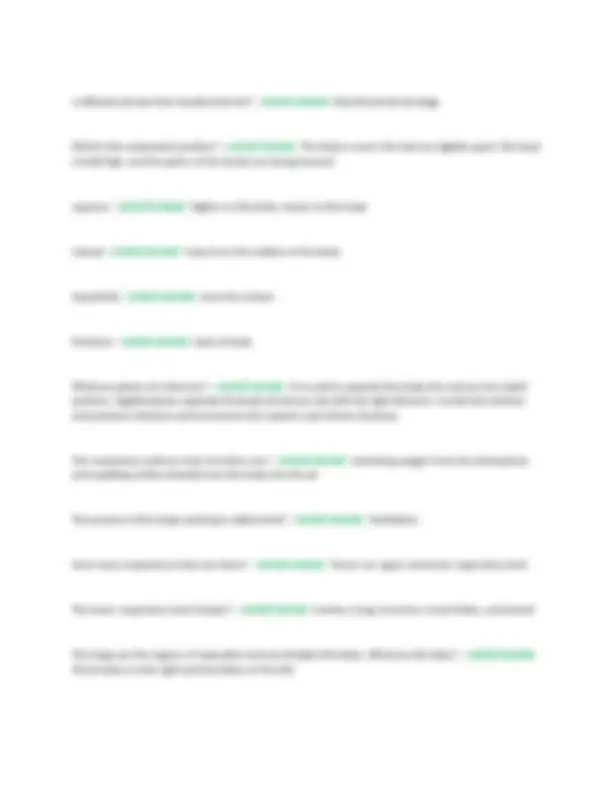
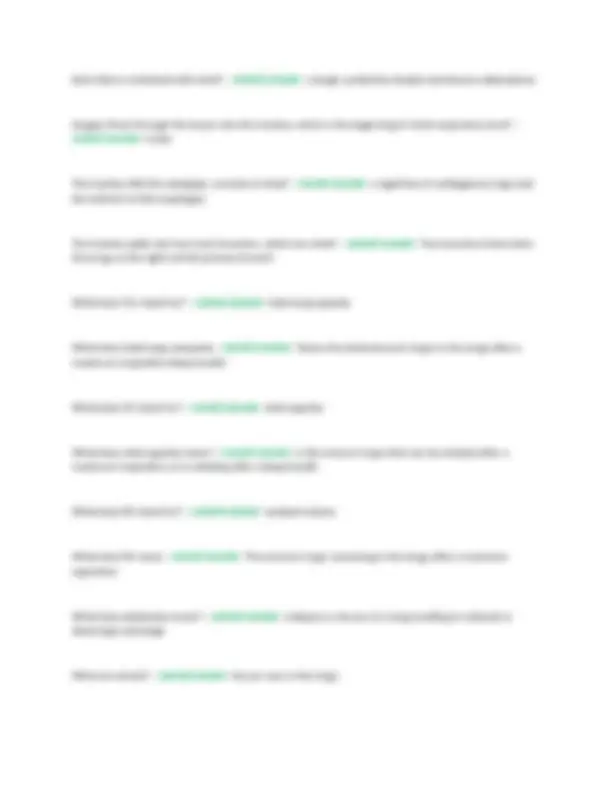
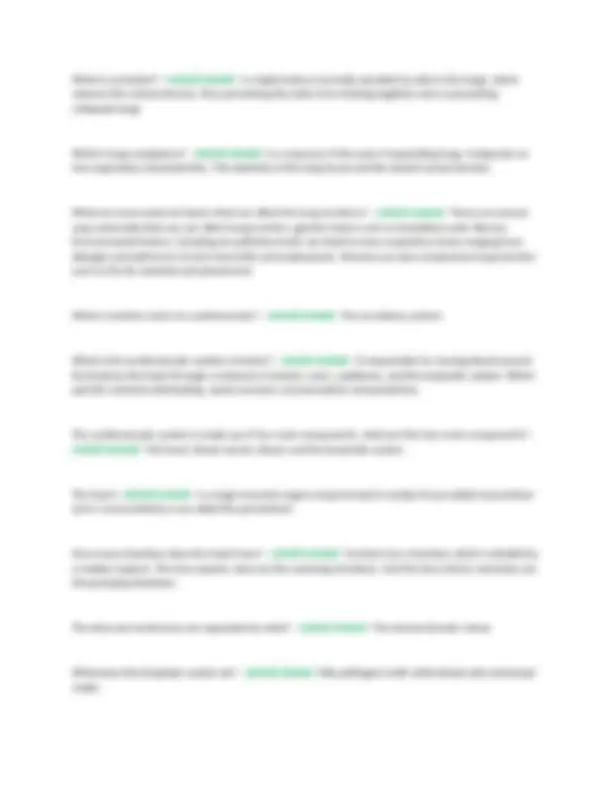
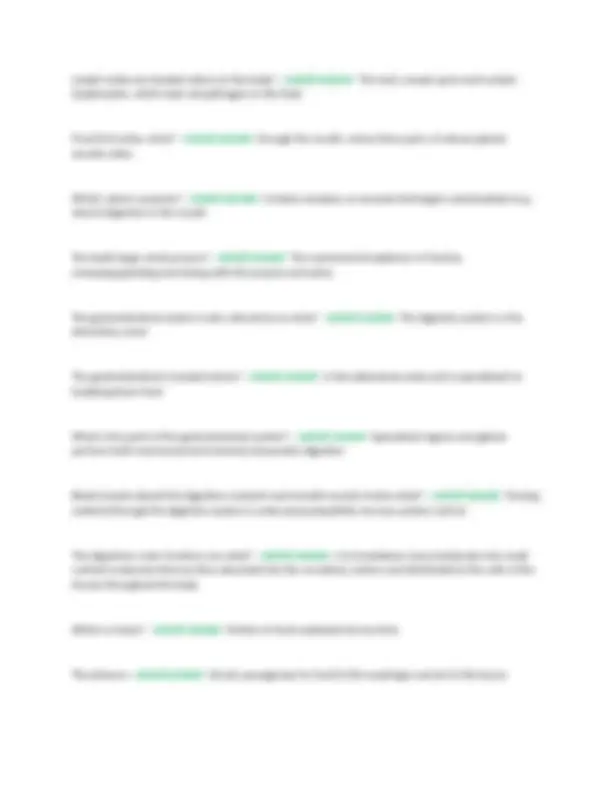
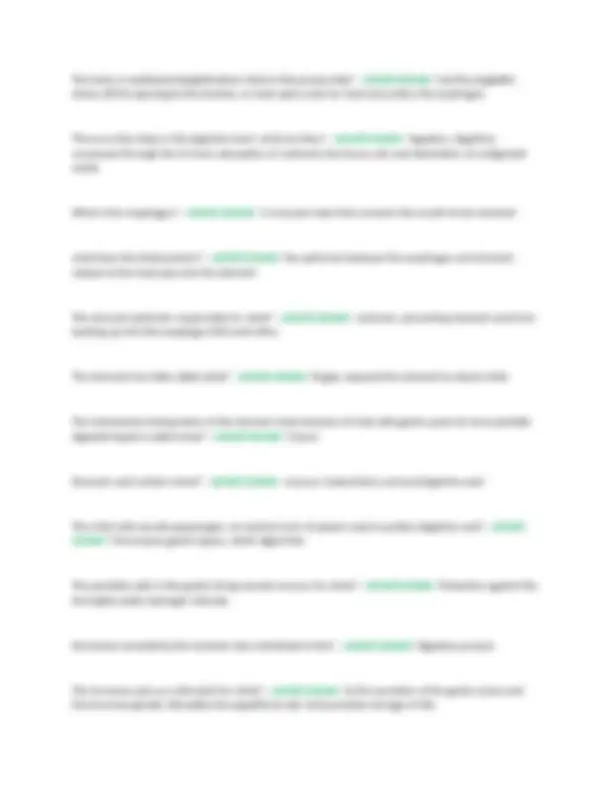
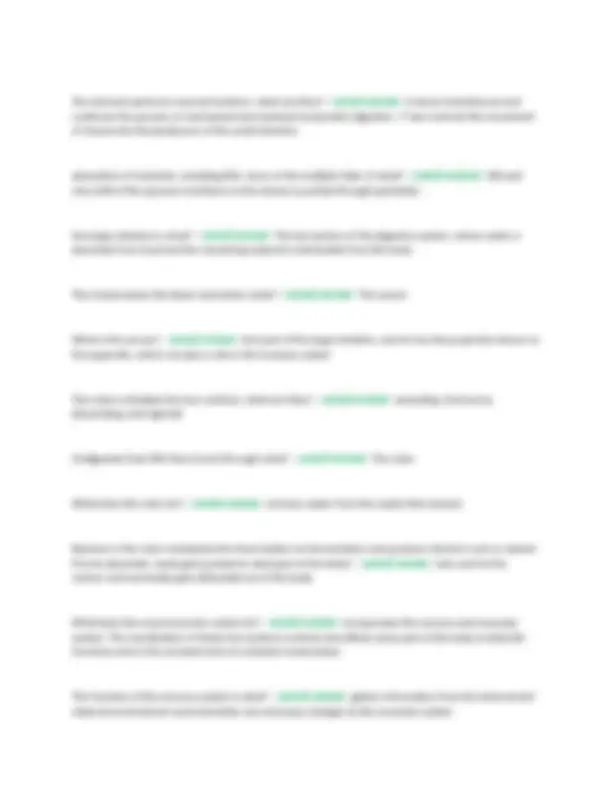
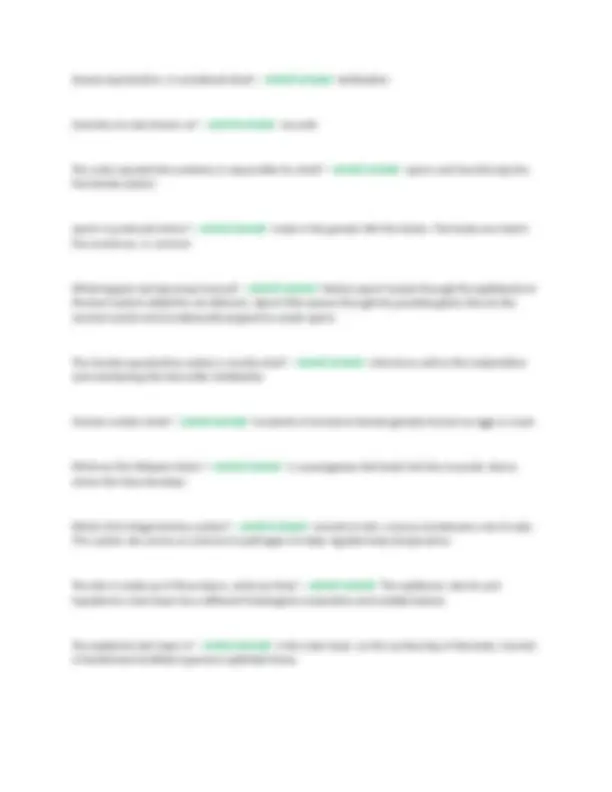
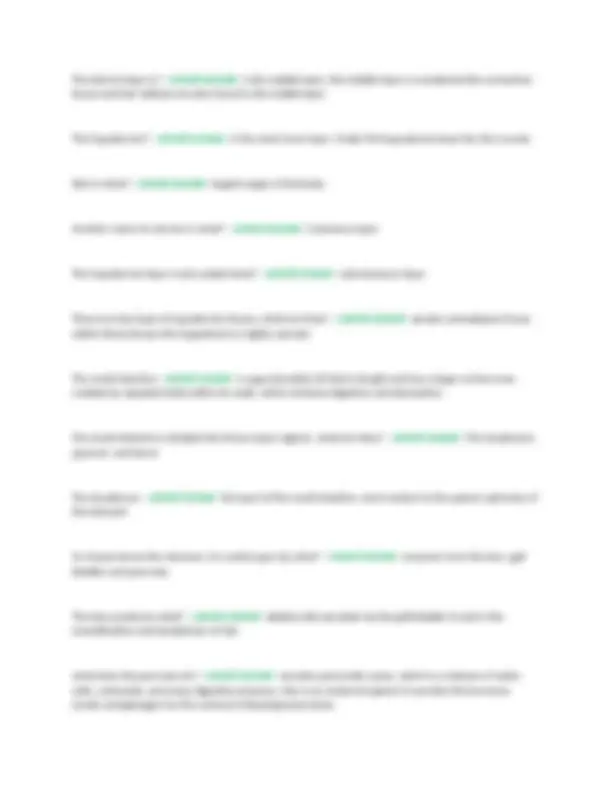
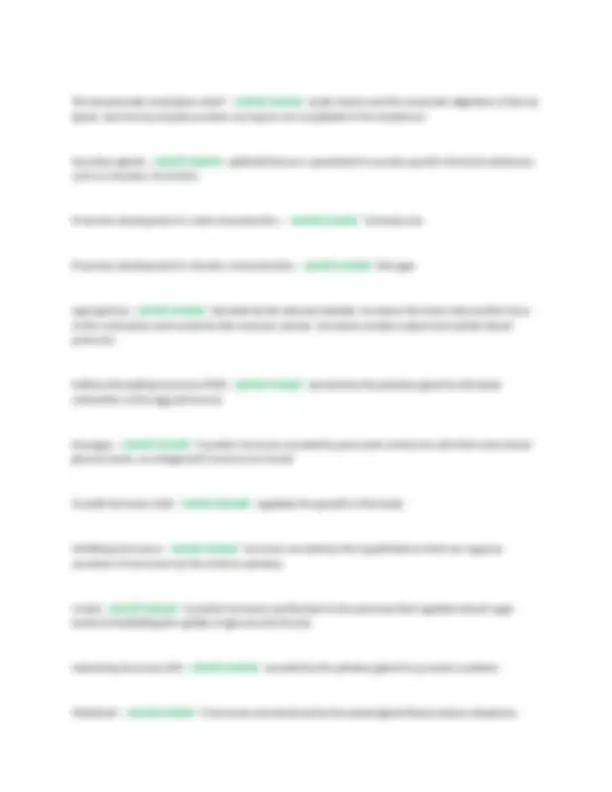
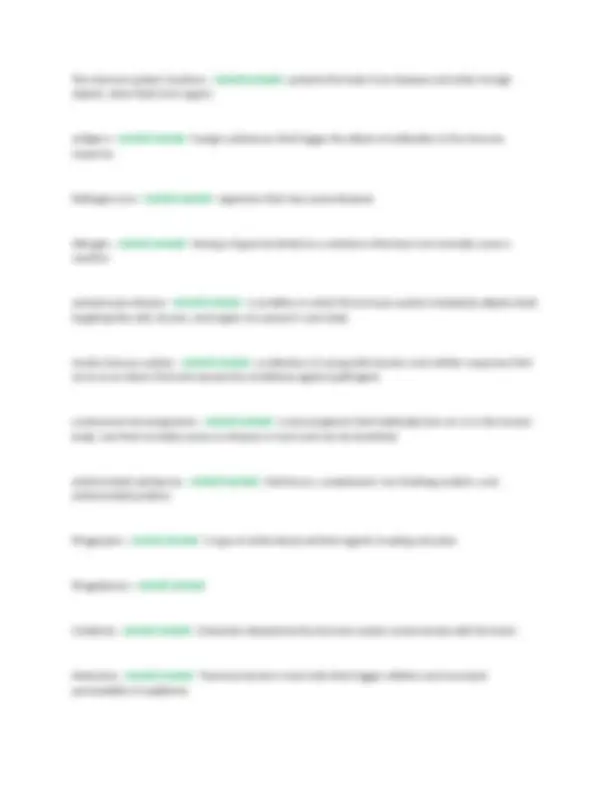
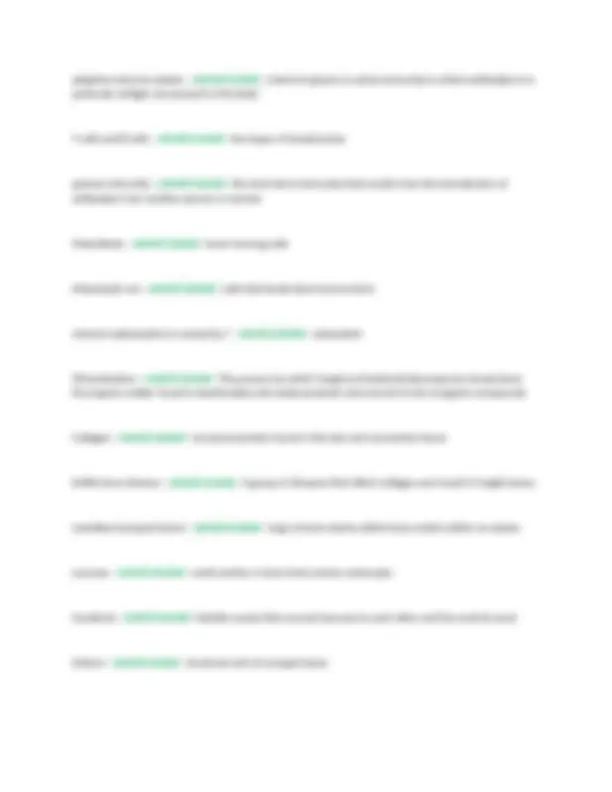
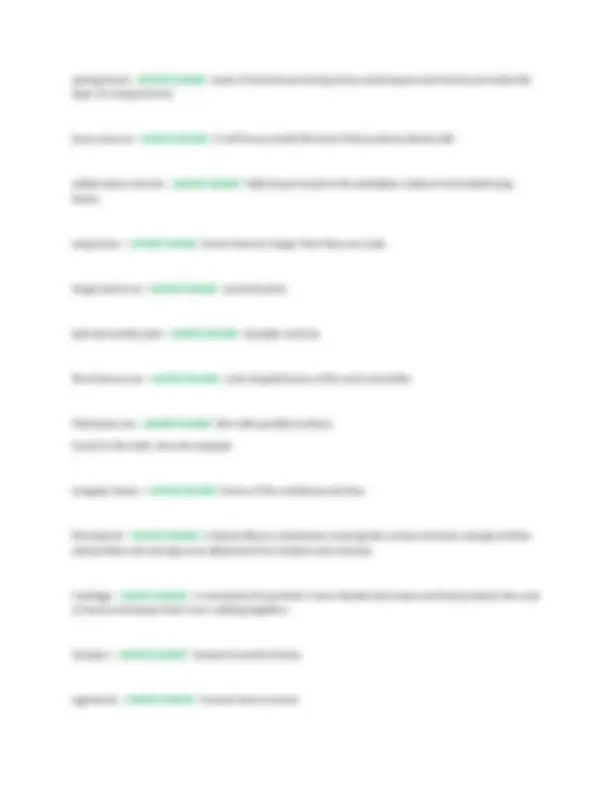
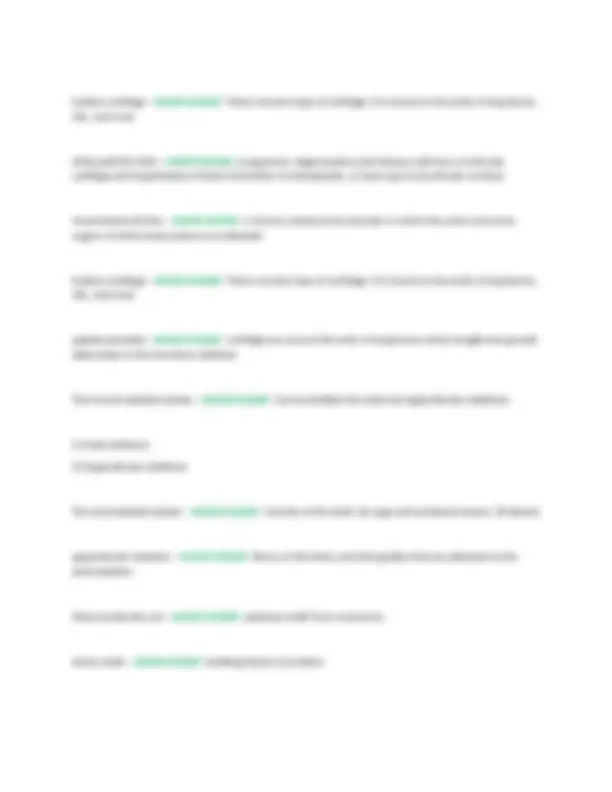
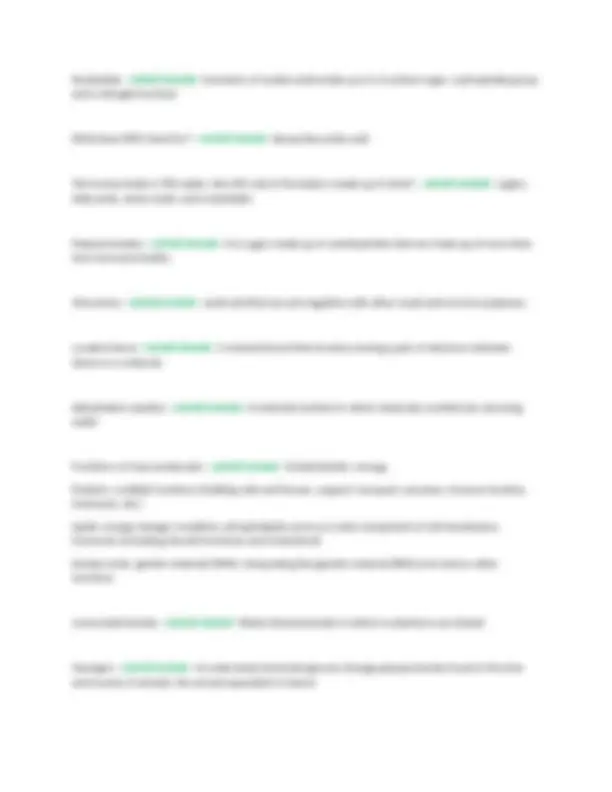
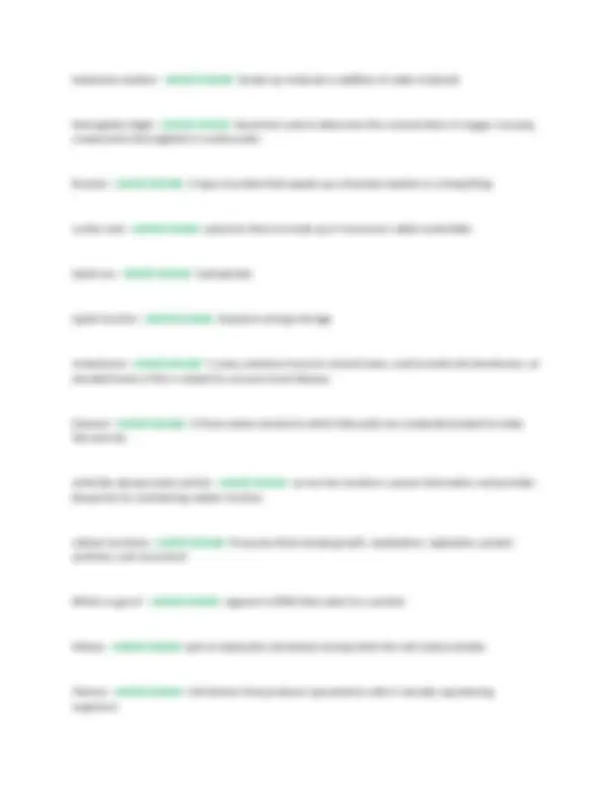
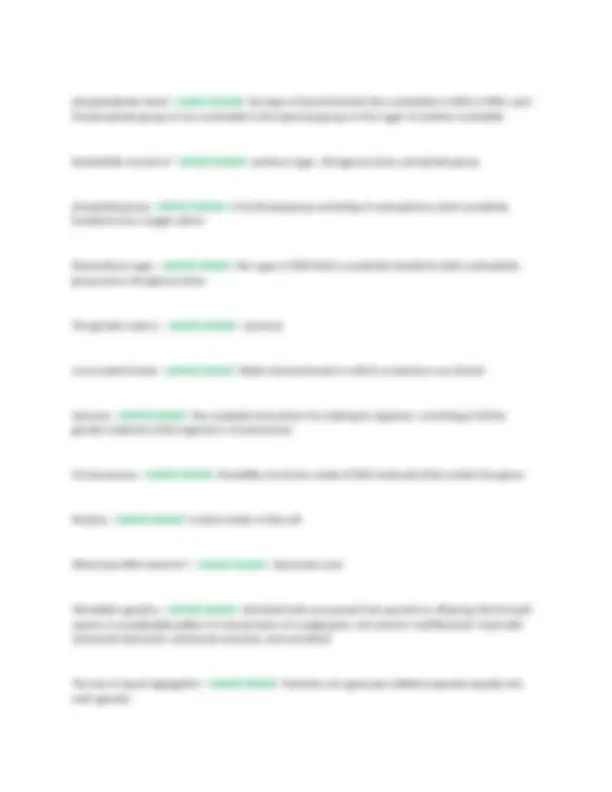
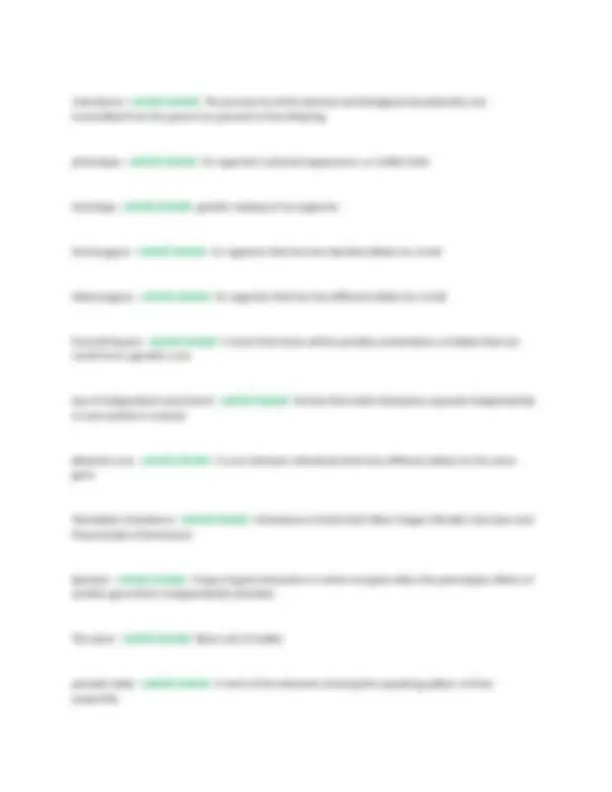
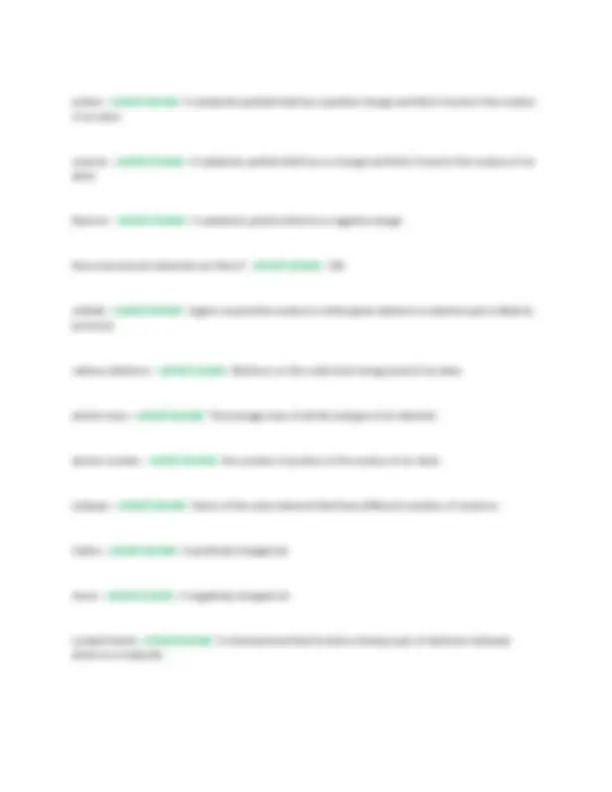
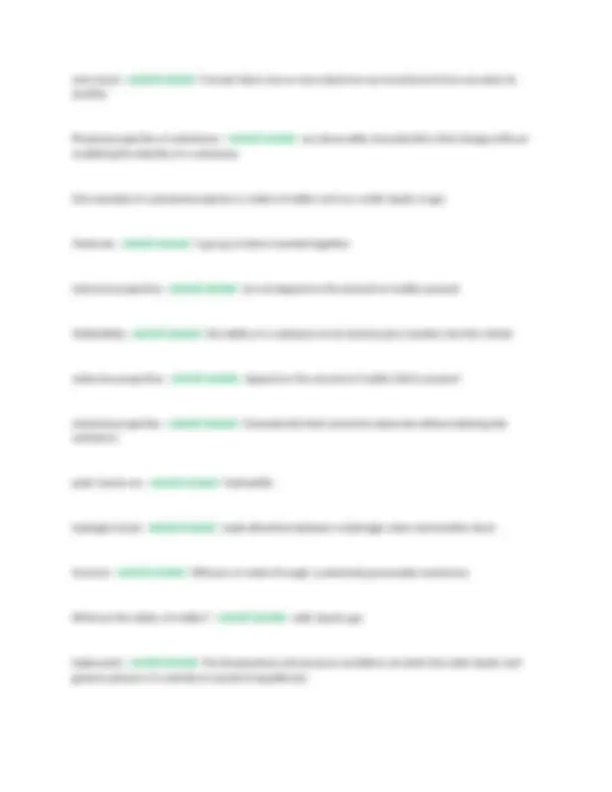
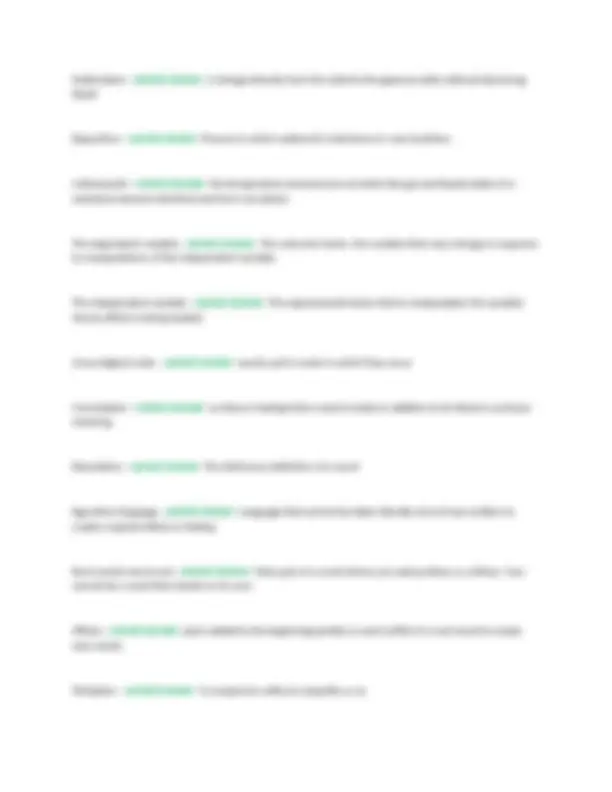
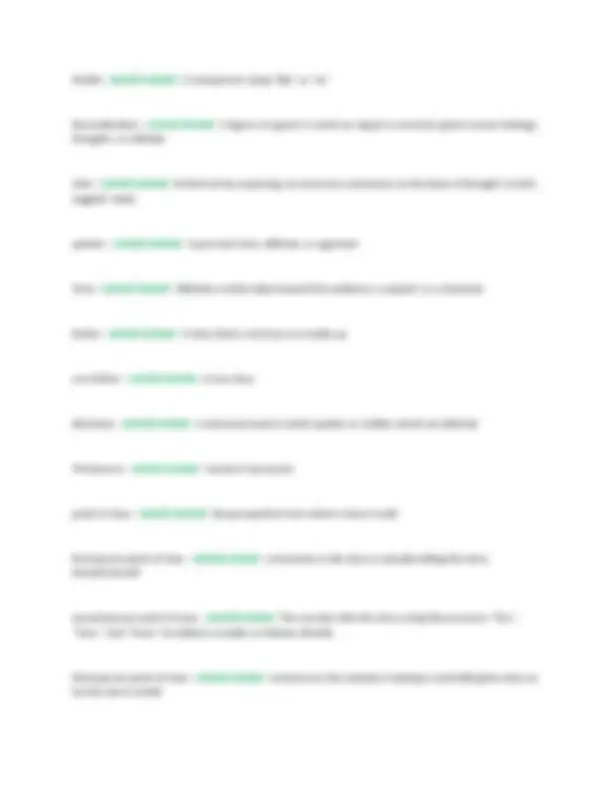
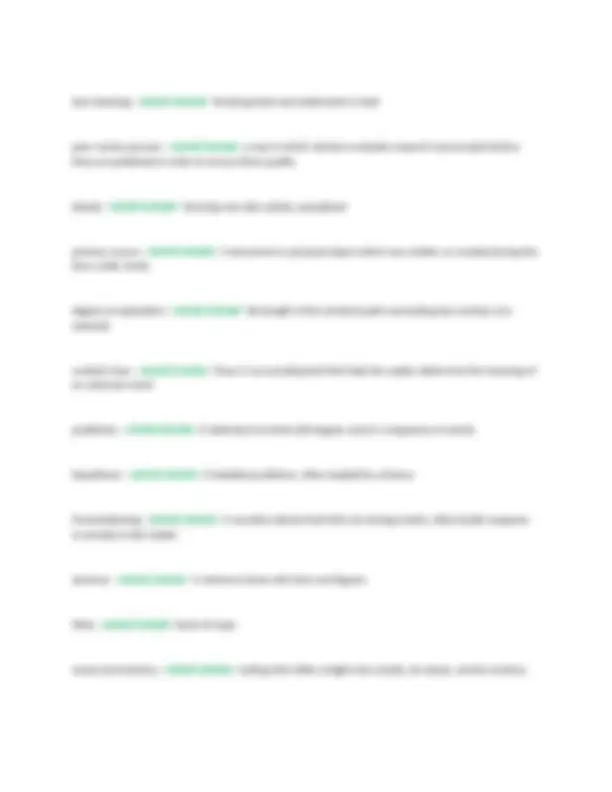
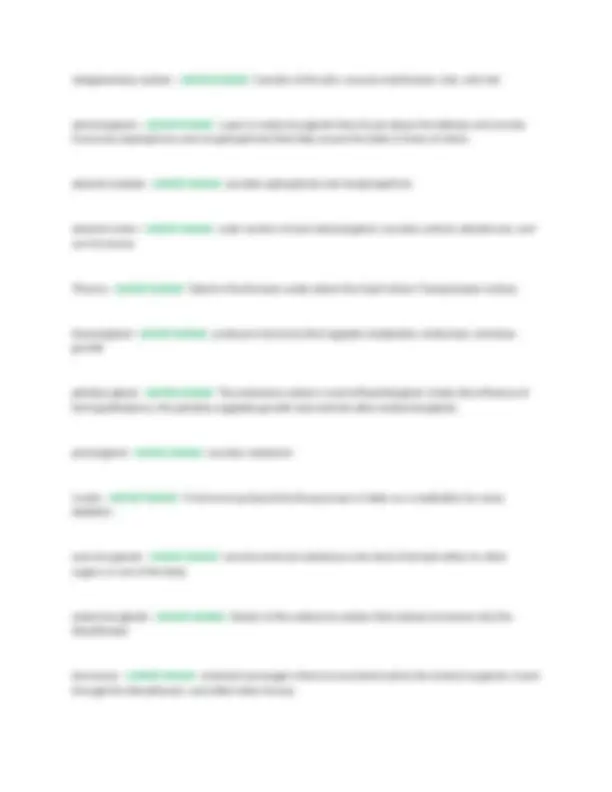
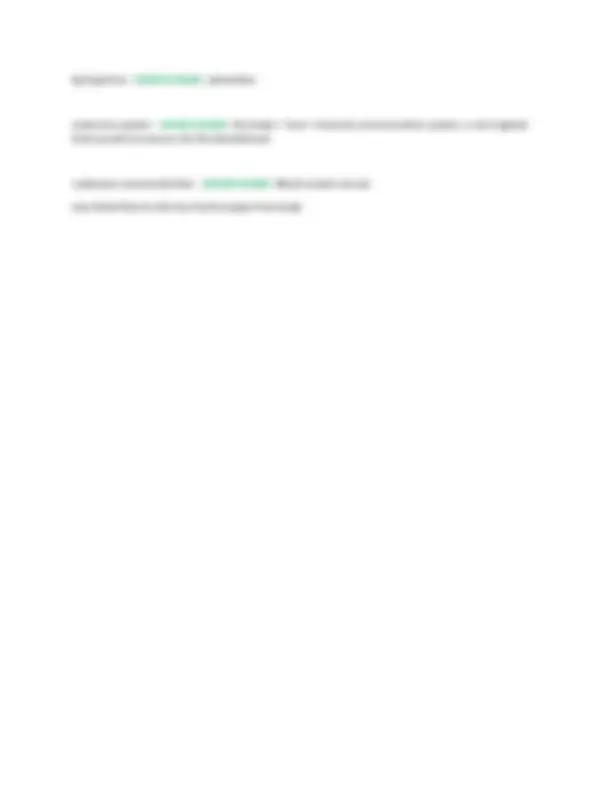


Study with the several resources on Docsity

Earn points by helping other students or get them with a premium plan


Prepare for your exams
Study with the several resources on Docsity

Earn points to download
Earn points by helping other students or get them with a premium plan
Community
Ask the community for help and clear up your study doubts
Discover the best universities in your country according to Docsity users
Free resources
Download our free guides on studying techniques, anxiety management strategies, and thesis advice from Docsity tutors
ATI TEAS EXAM STUDY GUIDE ALREADY GRADED A+
Typology: Exams
1 / 32

This page cannot be seen from the preview
Don't miss anything!

























Every cell in the human body has three main parts - correct answer plasma membrane, cytoplasm, nucleus Each cell has additional structures called organelles that carry out metabolic like AKA what - correct answer Cellular Function The Plasma Membrane is made up of what? - correct answer phospholipid bilayer, Imbedded with proteins Cytoplasm - correct answer The jelly-like semifluid substance inside of the membrane that contains the organelles The nucleus - correct answer Control center of the cell, the most prominent organelle in the cell. It's protected by a double membrane and contains genetic material in the form of the nucleic acid. The rough endoplasmic reticulum AKA (the rough ER) - correct answer covered with ribosomes - a series of tubes that transport proteins "packaging and transportation" and is the outer membrane of the nucleus Proteins - correct answer Are made on the ribosomes of the Rough ER Groups of similar cells that work together to perform a singular function are classified as what? - correct answer Tissues There are four types of tissues - correct answer epithelial, connective, muscle, nervous Epitherial Tissue - correct answer Covers body surface, lines the body and serves as a protective outer layer barrier
connective tissue - correct answer Connects other tissues to each other and serves to bind and support body parts muscle tissue - correct answer Moves the body and its contents by contractions nervous tissue - correct answer receives stimuli from the internal/external environment and communicates through the electrical impulses with the rest of the body. Organs - correct answer Tissues are organized into organs. Organs consists of two or more different tissues and have a specific shape and functions Not all organs are internal. What organ is considered external? - correct answer Skin is an organ on the outside of the body that is made up of the body that is made up of all four tissue types and that's main function is as a protective barrier. The kidney is an internal organ with a definite shape consisting of epithelial, connective and nervous tissue. What is its main function? - correct answer The Kidneys main function is to recycle nutrients and filter wastes from the blood Organ systems - correct answer related organs with a common multifaceted function makeup an organ system. For example, the digestive system has the function of breaking down and processing food we eat and eliminates the solid waste. How do organ systems work together? - correct answer Organ systems function together with a synchronized mechanism of many organs including the mouth, esophagus, stomach, intestines, liver, gall bladder, and pancreas. The organ system works together to maintain homeostasis in the human organism. How does the respiratory system function? - correct answer The function of exchanging the gas of CO for 02 with the coordinated effort of the organs, of the pharynx, larynx, bronchus, trachea, lungs and diagram. What is anatomical Terminology? - correct answer a set of vocabulary used by health professionals to refer to parts, regions, directions, and planes on the human body
Each lobe is contained with what? - correct answer a tough, protective double membrane called pleura Oxygen flows through the larynx into the trachea, which is the beginning of what respiratory tract? - correct answer Lower The trachea AKA the windpipe, consists of what? - correct answer a rigid tine of cartilaginous rings and lies anterior to the esophagus The trachea splits into two main branches, which are what? - correct answer Two branches that enters the lungs as the right and let primary bronchi What does TLC stand for? - correct answer total lung capacity What does total lung compacity - correct answer Means the total/amount of gas in the lungs after a maximum inspiration/deep breath. What does VC stand for? - correct answer vital capacity What does vital capacity mean? - correct answer is the amount of gas that can be exhaled after a maximum inspiration as in exhaling after a deep breath What does RV stand for? - correct answer residual volume What does RV mean - correct answer The amount of gas remaining in the lungs after a maximum expiration What does atelectasis mean? - correct answer collapse or closure of a lung resulting in reduced or absent gas exchange What are alveoli? - correct answer tiny air sacs in the lungs
What is surfactant? - correct answer Is a lipid mixture normally secreted by cells in the lungs, which reduces the surface tension, thus preventing the sides from sticking together and or preventing collapsed lungs. What is lung compliance? - correct answer is a measure of the ease of expanding lungs, it depends on two respiratory characteristics. The elasticity of the lung tissue and the alveoli surface tension. What are some external factors that can affect the lung functions? - correct answer There are several ways externally that you can affect lung function, genetic factors such as hereditary cystic fibrosis. Environmental factors, including air pollution/mold, can lead to many respiratory issues ranging from allergies and asthma to chronic bronchitis and emphysema. Illnesses can also compromise lung function such as the flu, bacteria and pneumonia. What is another name for cardiovascular? - correct answer The circulatory system What is the cardiovascular systems function? - correct answer IS responsible for moving blood around the body by the heart through a network of arteries, veins, capillaries, and the lymphatic system. Which permits nutrients distributing, waste removal, communication and protection. The cardiovascular system is made up of four main components, what are the four main components? - correct answer The heart, blood vessels, blood, and the lymphatic system The heart - correct answer Is a large muscular organ compromised of cardiac tissue called myocardium and is surrounded by a sac called the pericardium How many chambers does the heart have? - correct answer Contains four chambers which is divided by a median septum. The two superior atria are the receiving chambers. And the two inferior ventricles are the pumping chambers. The atria and ventriculus are separated by what? - correct answer The atrioventricular valves What does the lymphatic system do? - correct answer Kills pathogens with white blood cells and lymph nodes
Oxygenated blood from the lungs travels via the pulmonary veins it's into what? - correct answer the left ventricles The systemic system carries what? - correct answer oxygenated blood when the left atrium contracts forcing blood through the left AV (bicuspid, mitral) valve into the left ventricle Contraction of the left ventricle pumps blood through what? - correct answer through the aortic semilunar valve, through the aorta towards the rest of the body. The closing AV makes the heart sounds. Blood pressure is measured by what? - correct answer in millimeters of mercury (mm Hg) The contraction (systole) of the heart causes the blood to push what? - correct answer To push against the muscular walls and recoils nd the pressure decreases to a minimum High blood pressure aka (hypertension) can cause what? - correct answer rupture of the smaller arteries and capillaries which could possibly lead to a stroke What is atherosclerosis caused by? - correct answer High blood pressure, diet high in saturated fats, lack of physical exercise, obesity What does systole mean? - correct answer Contraction of the heart The lymphatic vessels are linked to what? - correct answer Lymph nodes and lymphatic capillaries. Like veins, lymph vessels are thinned walled and continued one-way valves to mountain flow in one direction only The lymph fluid is filtered with what? - correct answer Through hundreds of small organs called lymph nodes distributed throughout the body Lymphatic capillaries are entwinned with what? - correct answer Cardiovascular capillaries and absorb excess tissue fluid and blood plasma that leaks from the capillaries
Lymph nodes are located where on the body? - correct answer The neck, armpit, groin and contain lymphocytes, which seek out pathogens in the fluid Food first enters what? - correct answer through the mouth, where three pairs of salivary glands secrete saliva What's saliva's purpose? - correct answer Contains amylase, an enzyme that begins carbohydrate (e.g. starch) digestion in the mouth The teeth begin what process? - correct answer The mechanical breakdown of food by chomping/grinding and mixing with the enzyme and saliva The gastrointestinal system is also referred to as what? - correct answer The digestive system or the alimentary canal The gastrointestinal is located where? - correct answer in the abdominal cavity and is specialized for breaking down food What is the point of the gastrointestinal system? - correct answer Specialized regions and glands perform both mechanical and chemical (enzymatic) digestion Blood vessels absorb the digestion nutrients and smooth muscle involve what? - correct answer Moving material through the digestion system is under parasympathetic nervous system control The digestions main functions are what? - correct answer is to breakdown macromolecules into small nutrient molecules that are then absorbed into the circulatory system and distributed to the cells of the tissues throughout the body What is a bolus? - correct answer Portion of food swallowed at one time The pharynx - correct answer throat; passageway for food to the esophagus and air to the larynx
The stomach performs several functions, what are they? - correct answer It stores food blouses and continues the process of mechanical and chemical (enzymatic) digestion. IT also controls the movement of chyme into the deuterium of the small intestine absorption of nutrients, including B12, occur in the multiple folds of what? - correct answer Villi and microvilli of the jejunum and ileum as the chyme is pushed through peristalsis the large intestine is what? - correct answer The last section of the digestive system, where water is absorbed from food and the remaining material is eliminated from the body The chyme leaves the ileum and enters what? - correct answer The cecum What is the cecum? - correct answer first part of the large intestine, and its has the projection known as the appendix, which can play a role in the humane system The colon is divided into four sections, what are they? - correct answer ascending, transverse, descending, and sigmoid Undigested food AKA feces travel through what? - correct answer The colon What does the colon do? - correct answer removes water from the waste that remains Bacteria in the colon metabolize the fecal matter via fermentation and produce vitamins such as vitamin K to be absorbed. waste gets pushed to what part of the body? - correct answer Gets sent to the rectum and eventually gets defecated out of the body What does the neuromuscular system do? - correct answer incorporates the nervous and muscular system. The coordination of these two systems controls and affects every part of the body in daily life functions and in the constant drive to maintain homeostasis The function of the nervous system is what? - correct answer gather information from the internal and external environment communication any necessary changes to the muscular system.
The neuromuscular system and muscular systems work together by what? - correct answer by distinctive cells called neurons that pass information using an electrical nerve impulse how do the neuromuscular and muscular system work? - correct answer information passes through hundreds of neurons much like the game telephone. Until it reaches the final destination of a muscle for an action to be performed Every movement muscularly happens from what? - correct answer The central nervous system from electrical impulse Once a stimulator is processed in the CNS, the peripheral motor nerves send different impulse to what?
Sexual reproduction, is considered what? - correct answer fertilization Gametes are also known as? - correct answer sex cells The male reproductive anatomy is responsible for what? - correct answer sperm and transferring into the female system sperm is produced where? - correct answer made in the gonads AKA the testes. The testes are held in the scrotal sac, or scrotum What happens during sexual arousal? - correct answer Mature sperm travels through the epididymis to the duct system called the vas deferens. Sperm then passes through the prostate gland, then to the seminal vesicle and to bulbourethral gland to create sperm. The female reproductive system is mostly what? - correct answer internal as well as the implantation and maintaining the fetus after fertilization Ovaries contain what? - correct answer hundreds of immature female gametes known as eggs or ovum What are the fallopian tubes? - correct answer Is a passageway that leads into the muscular uterus, where the fetus develops What is the integumentary system? - correct answer consists of skin, mucous membranes, hair & nails. This system also serves as a barrier to pathogens & helps regulate body temperature. The skin is made up of three layers, what are they? - correct answer The epidermis, dermis and hypodermis. Each layer has a different histological composition and notable feature The epidermis skin layer is? - correct answer is the outer layer, on the surface/top of the body. Consists of keratinized stratified squamous epithelial tissue
The dermis layer is? - correct answer is the middle layer, the middle layer is considered the connective tissue and hair follicles are also found in the middle layer The hypodermis? - correct answer is the most inner layer. Under the hypodermis layer lies the muscle Skin is what? - correct answer largest organ of the body Another name for dermis is what? - correct answer Cutaneous layer The hypodermis layer is also called what? - correct answer subcutaneous layer There are two type of hypodermis tissues, what are they? - correct answer aerator and adipose tissue, within these tissues the hypodermis is highly vascular The small intestine - correct answer Is approximately 18 feet in length and has a large surface area created by repeated folds within its walls, which enhance digestion and absorption. The small intestine is divided into three major regions, what are they? - correct answer The duodenum, jejunum, and ileum The duodenum - correct answer first part of the small intestine, short section to the pyloric sphincter of the stomach As chyme leaves the stomach, it is acted upon by what? - correct answer enzymes from the liver, gall bladder and pancreas The liver produces what? - correct answer alkaline bile secreted via the gall bladder to aid in the emulsification and breakdown of fats what does the pancreas do? - correct answer secretes pancreatic juices, which is a mixture of water, salts, carbonate, and many digestive enzymes. Also is an endocrine gland, it secretes the hormone insulin and glycogen for the control of blood glucose levels.
Oxytocin - correct answer A hormone released by the posterior pituitary that stimulates uterine contractions during childbirth and milk ejection during breastfeeding. parathyroid hormone (PTH) - correct answer regulates calcium and phosphorus metabolism realeasing hormones - correct answer In the hypothalamus, stimulates certain production of hormones. Thyroid Hormone (TH) - correct answer The major hormone secreted by thyroid follicles; stimulates enzymes concerned with glucose oxidation. What is the primary organ for the urinary system? - correct answer The kidney The kidney - correct answer organ that removes urea, excess water, and other waste products from the blood and passes them to the ureter The kidneys are divided by two major regions, what are they? - correct answer The renal cortex and renal medulla renal cortex - correct answer outer region of the kidneys glomerulus - correct answer A ball of capillaries surrounded by Bowman's capsule in the nephron and serving as the site of filtration in the vertebrate kidney. Bowman's capsule - correct answer cup-shaped structure of the nephron of a kidney which encloses the glomerulus and which filtration takes place. proximal tubule - correct answer In the vertebrate kidney, the portion of a nephron immediately downstream from Bowman's capsule that conveys and helps refine filtrate. tubular reabsorption - correct answer selectively returns 99% of substances from filtrate to blood in renal tubules and collecting ducts
nephron - correct answer functional unit of the kidney Plasma - correct answer Liquid part of blood Filterate - correct answer liquid that has passed through a filter renal pelvis - correct answer central collecting region in the kidney ureter - correct answer A duct leading from the kidney to the urinary bladder. urine - correct answer Fluid wastes removed from the body by the kidneys urinary bladder - correct answer saclike organ in which urine is stored before being excreted renal artery - correct answer blood vessel that carries blood to the kidney renal vein - correct answer blood vessel that carries blood away from the kidney and toward the heart Urea acid - correct answer blood volume - correct answer The total amount of blood circulating within the body The renin-angiotensin-aldosterone system - correct answer a hormone cascade pathway that helps regulate blood pressure and blood volume angiotensin II - correct answer increases blood pressure by stimulating kidneys to reabsorb more water and by releasing aldosterone
adaptive immune system - correct answer a kind of passive or active immunity in which antibodies to a particular antigen are present in the body T cells and B cells - correct answer two types of lymphocytes passive immunity - correct answer the short-term immunity that results from the introduction of antibodies from another person or animal. Osteoblasts - correct answer bone forming cells Osteoclasts are - correct answer cells that break down bone matrix mineral reabsorption is caused by? - correct answer osteoclasts Mineralization - correct answer The process by which fungal and bacterial decomposers break down the organic matter found in dead bodies and waste products and convert it into inorganic compounds Collagen - correct answer structural protein found in the skin and connective tissue brittle bone disease - correct answer A group of diseases that affect collagen and result in fragile bones Lamellae (compact bone) - correct answer rings of bone matrix within bone matrix within an osteon Lacunae - correct answer small cavities in bone that contain osteocytes Canaliculi - correct answer Hairlike canals that connect lacunae to each other and the central canal Osteon - correct answer structural unit of compact bone
spongy bone - correct answer Layer of bone tissue having many small spaces and found just inside the layer of compact bone. bone marrow - correct answer A soft tissue inside the bone that produces blood cells yellow bone marrow - correct answer fatty tissue found in the medullary cavity of most adult long bones long bones - correct answer bones that are longer than they are wide hinge joints are - correct answer synovial joints ball and socket joint - correct answer shoulder and hip Short bones are - correct answer cube shaped bones of the wrist and ankle Flat bones are - correct answer thin with parallel surfaces found in the skull, ribs and scapulae irregular bones - correct answer bones of the vertebrae and face Periosteum - correct answer A dense fibrous membrane covering the surface of bones (except at their extremities) and serving as an attachment for tendons and muscles. Cartilage - correct answer A connective tissue that is more flexible than bone and that protects the ends of bones and keeps them from rubbing together. Tendons - correct answer Connect muscle to bone Ligaments - correct answer Connect bone to bone